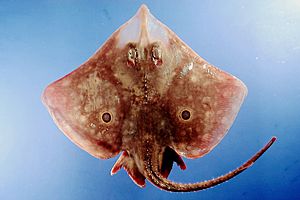Rostroraja texana facts for kids
Quick facts for kids Rostroraja texana |
|
|---|---|
 |
|
| Conservation status | |
| Scientific classification | |
| Kingdom: | |
| Phylum: | |
| Class: | |
| Subclass: | |
| Order: |
Rajiformes
|
| Family: | |
| Genus: |
Rostroraja
|
| Species: |
R. texana
|
| Binomial name | |
| Rostroraja texana (Chandler, 1921)
|
|
| Synonyms | |
|
Raia texana Chandler, 1921 |
|
The roundel skate (Rostroraja texana) is a type of fish that has a body made of cartilage, not bones. It is also called the Texas clearnose skate. You can find this unique fish in the warm waters of the Gulf of Mexico, off the coast of Southeast Florida, and near the Yucatan Peninsula.
Contents
What Does It Look Like?
The roundel skate has a body shaped like a diamond. Its snout, which is short and rounded, has a clear patch of skin on each side. The top of its body is usually a plain chocolate brown color, but sometimes it has darker spots.
A cool feature of this skate is its two dark eyespots. These spots have pale pink edges and are located on the middle of its back. These spots might help confuse animals that want to eat the skate, making them think the spots are real eyes.
The roundel skate has a row of small thorns running down the middle of its back. But don't worry, these thorns are not poisonous! Its tail is medium-sized and has a small fin near the tip, plus a tiny tail fin.
Male roundel skates become adults when they are about 5 years old and around 44 centimeters (about 17 inches) long. Females mature a year later, at about 53 centimeters (about 21 inches) long.
Where Do Roundel Skates Live?
The roundel skate lives in the ocean waters off the southeastern coast of Florida. It also lives in the Gulf of Mexico and a shallow area called the Campeche Bank, which is near the northern coast of the Yucatan Peninsula.
These skates usually live on the ocean floor, where there is sand, crushed shells, or small stones. They can be found in waters up to about 180 meters (about 590 feet) deep.
What Do Roundel Skates Eat?
Adult roundel skates mostly eat shrimp, which makes up about 65% of their diet. They also eat fish, about 25% of their food, and sometimes crabs and other crustaceans.
Younger skates, called juveniles, eat even more shrimp. Over 90% of their diet is shrimp, with a small amount of tiny fish.
Reproduction and Life Cycle
Male and female roundel skates look a bit different from each other, with males usually being smaller. When they reproduce, the male's claspers (special organs) are used to fertilize the female's eggs inside her body.
After fertilization, the egg moves down the female's body. It gets covered in a special jelly-like substance and yolk, which will feed the baby skate. Then, the egg is placed inside a tough, rectangular collagen case. This case is often called a "mermaid's purse".
The mermaid's purse is light brown, flat on one side, and rounded on the other. It has curly tendrils at its corners that help it attach to things on the seafloor. Inside this case, the baby skate, called an embryo, grows by feeding on the yolk. After several months, a fully formed baby skate, about 11 centimeters (about 4 inches) long, hatches from the mermaid's purse.
Conservation Status
The IUCN is an organization that checks on the health of animal populations around the world. They have looked at the roundel skate and placed it in their "Red List of Threatened Species".
Good news! The roundel skate is listed as "Least Concern." This means that, for now, there are plenty of roundel skates in the wild, and they are not considered to be in danger of disappearing.
See also
 In Spanish: Raja texana para niños
In Spanish: Raja texana para niños


